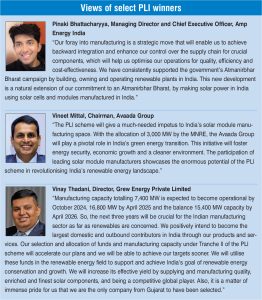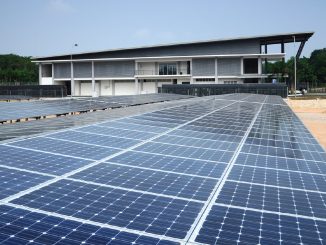As India moves towards installing more than 200 GW of new solar power capacity by 2030, there is a collective aim to ensure that a large part of this is made from locally sourced components. This is a massive undertaking for the Indian solar industry, which depends significantly on imports of solar cells and modules from China and other countries.
There has been a thrust on promoting domestic solar manufacturing for a few years now, with policy initiatives such as safeguard duties, manufacturing-linked tenders and domestic content requirements being introduced in the past to encourage the adoption of local products. These initiatives were successful only to a certain extent and developers continued to rely heavily on imported products. The launch of the attractive production-linked incentive (PLI) scheme and two tranches of successful capacity and amount allocations under this have brought domestic manufacturing to the fore, with developers too wanting a piece of the pie.
Recent geopolitics and supply chain issues have significantly helped in tipping the scales in favour of domestic cell and module manufacturing. First, the unprecedented global impact of the Covid pandemic left factories shut and cargo stranded, leading to severe equipment shortages and subsequent project delays. Since a large part of the solar cells and modules used in Indian projects are imported, capacity addition was significantly impacted. This was followed by global supply chain shortages and price hikes for glass and polysilicon, as well as essential commodities and metals. Moreover, the energy crisis owing to the Russia-Ukraine conflict, rising freight prices and currency volatility complicated matters further.
All these factors have made the case stronger for improving domestic manufacturing capabilities, and the government now has a massive plan in place for precisely that. Basic customs duty (BCD) has already been active for over a year and the Approved List of Models and Manufacturers (ALMM) has put a further restriction on imports. While both these measures limit the dependence on imports, the PLI scheme aims to develop India’s domestic solar manufacturing industry on a large scale and ensure the reliability of supply chains in the years to come.

Implications of BCD and ALMM
In March 2021, the Ministry of New and Renewable Energy (MNRE) announced a BCD of 25 per cent on solar cell imports and 40 per cent on solar module imports. This duty came into effect from April 1, 2022 and made imports more expensive, thus creating a more level playing field for domestic manufacturers. There has been no notification on the sunset period for this BCD. Moreover, the imposition of BCD was not considered a “change in law” in later bids, owing to there being sufficient time between the announcement and the actual implementation of BCD.
The announcement of BCD created concerns regarding supply chains and module procurement, which were already getting impacted owing to the pandemic and associated disruptions, and in many cases, led to delays in project completion. Many in the industry felt that the BCD imposition should have been done in phases to reduce its impact on developers. Thus, in January 2023, the MNRE decided to extend the deadline for completion of solar and wind-solar hybrid projects for which bids had been finalised before March 9, 2021, to March 20, 2024.
As expected, the imposition of BCD along with global supply chain concerns and the rise in GST rates for solar cells, modules and inverters to 12 per cent have led to an increase in solar power tariffs. These have risen significantly since the Solar Energy Corporation of India’s (SECI) 1,785 MW auction for solar projects in Rajasthan in December 2021, at which the lowest bid was Rs 2.17 per unit. In comparison, in Maharashtra’s latest solar auction in April 2023, the lowest tariff went up to Rs 2.87 per unit and in the previous auction, in December 2022, the lowest bid was registered at Rs 2.90 per unit. Gujarat too has witnessed higher tariffs in recent months with the solar auctions in January 2023 and September 2022 witnessing the lowest discovered tariffs of Rs 2.51 per unit and Rs 2.49 per unit respectively. Tariffs are expected to remain in this range if the uncertainties in supply chains continue.
Another important but often debated policy intervention is the ALMM, in which the MNRE has listed eligible models and manufacturers of solar modules complying with BIS standards. The first list was notified in March 2021 and has since then been updated many times. As anticipated, the ALMM comprises domestic manufacturers and their products, thus effectively restricting the use of imported cells and modules for projects, which must comply with this list.
Earlier, only the models and manufacturers on this list were eligible for government projects, government-assisted projects, projects set up for electricity sale to the government and projects under government schemes and programmes. Later, this list was also made compulsory for open access and net metering projects. This move did not sit well with developers as they felt that since these projects do not get any government subsidy, they should be free from the ALMM. Moreover, India’s domestic manufacturing capabilities are insufficient to cater to the huge requirements of the expanding solar market. Thus, developers were facing challenges in sourcing the required equipment for their projects.

In view of this, the MNRE announced in March 2023 that the ALMM, and subsequent amendments and clarifications, would be in abeyance for one financial year. All solar projects that are commissioned by March 2024 will be exempt from the requirement of procuring solar PV modules that comply with the ALMM. The new order is expected to provide relief to the solar industry as it allows developers to source imported modules for their projects. The temporary removal of the ALMM will also help boost capacity addition in the country. However, this move will benefit the solar segment only if sufficient manufacturing capacity comes up in the next one year that can cater to the requirements of the growing Indian market.
PLI gives a boost to manufacturing
While module manufacturing has scaled up significantly over the past few years, the country needs to build a base for making polysilicon ingots, wafers and cells, which still need to be imported. Moreover, the Indian solar industry lacks an integrated manufacturing set-up from silicon to modules, which must be set up from scratch.
For this reason, the government launched a PLI scheme in April 2021 to develop infrastructure that will scale-up the domestic manufacturing of high efficiency solar modules and ensure self-reliance in the solar industry by reducing imports. As a part of this scheme, interested solar PV manufacturers will be selected through a transparent process and will receive the sanctioned PLI for a period of five years after the commissioning of the manufacturing plants based on domestic sales of modules. The programme has been designed to give more weightage to manufacturers that set up fully integrated facilities – that is, manufacturing of polysilicon, wafers, ingots, cells and modules.
The Indian Renewable Energy Development Agency allocated a total integrated capacity of 8,737 MW under PLI Tranche I during November-December 2021 to three bidders – Adani Infrastructure, Reliance New Energy and Shirdi Sai Electricals. The total outlay for the PLI scheme initially was Rs 45 billion; an additional allocation of Rs 195 billion was announced for Tranche II in February 2022..
In November 2022, SECI invited applications from solar manufacturers to establish GW-scale manufacturing facilities for Tranche II of the PLI scheme. In March 2023, the government allocated a total of 39,600 MW of domestic solar PV module manufacturing capacity under this tranche to 11 companies – Indosol Solar, Reliance New Solar Energy, FS India Solar Ventures, Waaree Energies, Avaada Ventures, ReNew Solar, JSW Renewable Technologies, Grew Energy, Vikram Solar, AMPIN Solar One and TP Solar. The total outlay under Tranche II of the PLI scheme is Rs 140 billion and the scheme is expected to bring in investments of Rs 930 billion. As part of this tranche, 7,400 MW of manufacturing capacity is expected to become operational by October 2024, 16,800 MW by April 2025 and the remaining 15,400 MW by April 2026.
The total domestic solar module manufacturing capacity allocated under the two tranches of the PLI scheme is 48,337 MW, with a cumulative support of over Rs 185 billion by the government. However, it will take some time for this manufacturing capacity to come up, and till then, the segment must remain dependent on imports.
Outlook
Various enabling measures have been taken to scale up the country’s domestic manufacturing capabilities. While certain issues must still be clarified, the overall progress has been encouraging. Project costs and tariffs have risen for now, but tendering activity, power offtake and investor interest remain high. Further, as the results of the PLI Tranche II show, the domestic manufacturing segment is now also attracting large renewable energy developers that want to build their own production bases and secure their supply chains. Meanwhile, the scale-up of fully integrated module facilities that have been allocated under the PLI scheme will take a few years to implement. Till then, imports are necessary to meet the growing demand of the solar segment. Further, till sufficient domestic manufacturing capabilities are in place, restrictive policies should be avoided as they hamper the overall growth of the solar market in India. N



